Introduction
The tips in this article are aimed to be applicable to most (if not all) decks, and I’ve tried to keep stuff like “play better cards/decks” out of here. This article isn’t about deck construction or deck choice. This article is about play decisions and matters pertaining to playing the game and not deckbuilding choices. I tried to keep any completely wild opinions largely out of this article where I could, and tried to stick to fact as much as possible, or at least the sort of content that opinions can be made from. With that in mind, this article is geared towards the sort of player who considers themselves moderately skilled but wants to improve and take every edge they can. I don’t think any of these tips are going to turn a first-time-player into the next world champion immediately, and I’m no perfect player myself, but, in my opinion, they’re the sort of thing that you need to know or do if you want any chance of becoming a world champion.
Netrunner’s a fairly overwhelming game, so if you’re a new player who’s struggling to maintain a cool head already, even without trying to do the things I’ve listed in this article and finding it hard to do them all, try doing one at a time. Work on each part of your game at a time, and it’s important that your brain is focused on the game. Ideally you want to be doing everything in this article ‘automatically’, so a slower approach to learning these tenets might help immensely.
A shout-out and thanks to accomplished player Tagore Nakornchai for proof reading this article.
1: Always Draw First (Except When You Shouldn’t)
Let me tell you a turn which is in almost all cases strictly incorrect as Corp: click one install; click two install; click three draw a card. If you’re planning on drawing in a turn, and as Corp, you should know what your three clicks are going to look like in almost every case before taking the first click and drawing is one of those options (unless you draw into something that changes your turn), it should happen first as it gives you more information and more options to evaluate, and could change what you would otherwise do in your turn. For completeness, an example where you might not know your three clicks exactly as Corp is if you plan on fast advancing into a Clot threat, but in this case you should have two sets of three clicks ‘planned’ and choose which one based on whether or not the Runner gets Clot or not.
You should draw first when you can for quite a few reasons. As we all know, in Netrunner, cards are options, and having more cards in your hand means you’ve got more options for what to do with your clicks. It follows from this that seeing what our options are earlier is better than seeing them later, and the card you see may very well change what you plan on doing or be something better than what you were going to do earlier. In the above example of install install draw, the drawn card could be an agenda that you want to protect HQ for, it could be a better piece of ICE that you’d rather install than one of the other two, or it could be something that’s better than installing that piece of ICE. To put it simply: drawing cards might improve your options and change what you want to do with the rest of the turn, so do it first.
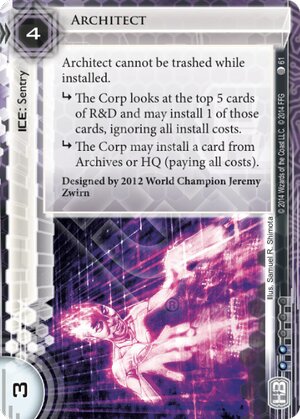
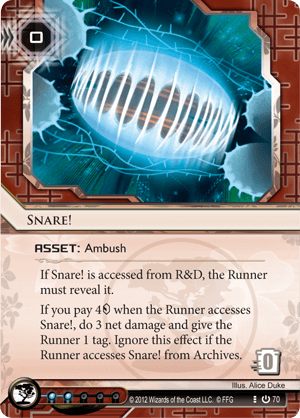
This doesn’t only apply to Corp, and very much applies to Runners too. There’s a few nuances with the Runner side of things, though, as it’s a perfectly fine turn to run then draw three times. Adding runs into the equation where you might want to click through scary ICE like Ichi 2.0 or react to the Architect you just let fire or Snare! you just accessed makes it a lot less clear cut. If you run an unprotected R&D, you might get an agenda (or access something tasty to trash like Caprice Nisei) and want to check again, up to a theoretical four times. If you know all the rezzed ICE on a server, you can run late into your turn if you don’t plan on re-running the server, and if you aren’t running for an access because of effects like Bank Job, Security Testing, or even if you’re just running an unprotected Archives to see the facedowns, aside from traps there are very few reasons not to run after drawing, as you will not need those clicks to the same server again, and you may draw cards that change your course of action (or even just draw a card like Dirty Laundry or Desperado to make it better). In the Runner’s case, whether or not drawing earlier rather than later is correct is dependent on what types of runs you’re making, but I leave that to the reader as something to decide for themselves in each individual case. I should reiterate, however, that unless your turn contains running and your turn involves drawing, in almost every case it is correct to draw before doing other actions. In the more complex cases, it’s very game state dependent, but this advice can still be used as a good guideline.
2: Plan Your Turns, Not Your Clicks
This leads on from the last section, as I believe the reason some people do draw late in the turn is because of improper turn planning. I’m going to make a bit of a strong assertion here that might make a few people raise their eyebrows: I believe that relying on click trackers in games of Netrunner makes you a worse player. Your turn is not a set of three or four discrete clicks and in cases where taking a click doesn’t change the game state (e.g. running/drawing), you shouldn’t need to think about what you’re doing next, you should have known before you took your last action. Your clicks are a set of actions you use to achieve a goal, and not individual things you should decide without regarding the others. To this extent, before you take any of your clicks, I believe you should have a plan/goal in your head of what you want to achieve, then a more concrete set of clicks you’ll probably take (if these clicks don’t include drawing/running, they should be concrete and should not change between clicks).


Even in situations where you need to draw/run, you should still have a goal in mind and still have a plan of clicks, but it should be of a forked path in your head. The fork in your turn should cover what happens if nothing changes or nothing goes wrong (this can almost always be mapped out as four clicks beforehand) and a slightly less concrete turn-idea that covers if things do go wrong (which could be as simple as “have clicks free in case something goes wrong during the run”). This goes hand in hand with preventing or minimising the damage of these threats to begin with; if you’re already thinking about what happens if things go wrong or if your options suddenly change, you’ll be hurt less when things do go wrong. Your threat prevention is built into the way you’re thinking about and planning your turns.
Planning turns instead of clicks strengthens your individual clicks themselves. Your reasoning for each click is backed up by your plan for the turn, this makes each click less of a whimsical decision and more of a cog for an already-designed machine. Planning your turns instead of clicks will also help you be a faster Netrunner player. Removing the need to ponder between each click means you can do most of your decision making on the opposing player’s turn (even if it’s more of an “if they do X, then I’ll Y, else I’ll Z”) and means you have a better idea about what you should doing on each click, condensing many decision points into one. It’s easy to see that a turn can be fast and fluid if you already know what you’re going to do beforehand.
3: Count Your Rez Costs
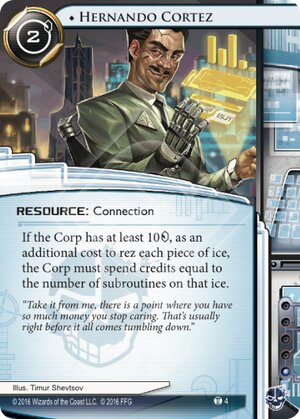 “You sure you got the number right?”
“You sure you got the number right?”
Picture this scenario: You’re Haas Bioroid: Engineering The Future, and you’ve got a completely unrezzed server containing a Tollbooth, Heimdall 2.0, and an Ash 2X3ZB9CY. R&D is also unrezzed, but protecting it is an Architect. For the sake of argument, the runner can break all of this ICE, but is fairly poor. You’re sitting pretty comfortably on 25 credits, and, feeling like you’ve got more than enough to score an agenda, install-advance-advance a Priority Requisition. Now sitting on 24 credits, you’re feeling pretty good, but as the runner runs R&D and you rez your Architect, you slowly realise you can’t afford to rez both pieces of ICE protecting your Priority Requisition and then score your agenda next turn (not even taking into account your Upgrade), meaning when the Runner runs your agenda, they can take it with relative ease. If you’d done some counting beforehand, you either wouldn’t have rezzed the Architect or wouldn’t have gone to score just yet.
When you’re going to score, you need to take into account the rez costs of your unrezzed ICE everywhere. Even if it looks like you’re rich, you don’t want to rez something and immediately regret it, and you should be very clear on whether scoring your agenda means you’re going to leave a central server open. Count your rez costs before you go for the play, recognise what you intend on rezzing on the Runner’s turn and what you intend on not rezzing. You don’t want to haphazardly realise that you can’t do something you wanted to do half way through the runner’s turn. Plan ahead. Recognise the credits you can spend over the next few turns, recognise what cards you can’t rez if you rez others, and recognise when you want to not rez certain things so you can rez others. If you’d counted beforehand, you’d know exactly what you’d be able to rez in each scenario and could evaluate whether or not you want to try and score with more information than without counting.
4: Pay Attention to R&D’s Top Card(s)
This one probably sounds pretty obvious, but I want to kind of highlight it in more ways than you’d normally think about this. The obvious application of this is that if you see an ICE on R&D and they install an ICE first click despite gaining three the turn previous, you can usually infer that there’s a high chance that the newly installed card is the ICE you just saw. You can extend this to other cards, such as if the Corp just drew a Celebrity Gift and hasn’t played it despite obviously struggling for econ, you could infer that they’re holding it back to conceal cards they don’t want you to see, steal or trash. Perhaps some runs on HQ are in order next turn?
Perhaps one of the biggest things to consider is the well-known idea of “R&D Lock”, which is the notion of not letting your opponent’s mandatory draw (and ideally more) be cards you’ve already seen. If you trash the top card of R&D, you need to take into account whether you’re giving your opponent “fresh” cards. If I run last click on R&D and trash a Jackson Howard off the top, though they’re one Jackson down, I remove an “R&D Lock” from my opponent, the card they draw with their mandatory draw will be fresh, unseen, and didn’t take a click. This could be game-losing if they draw into an Accelerated Beta Test with a Biotic Labor in hand with 5 points scored. Bear all of this in mind when considering trashing cards from R&D. How many fresh cards can you afford to give the Corp? Is trashing the card off R&D better than giving your opponent fresh cards? It depends on the game state, but it’s always something you should consider. As Runner, always bear in mind what cards the Corp is about to draw, and what you left on top of R&D.
Of course, what cards the Runner has seen on top of R&D also affect your play as Corp. If you’re playing an NBN deck and your opponent saw a PAD Campaign off R&D last turn, they may assume that the PAD Campaign is the next card you install. You can try and be cheeky by throwing out an AstroScript Pilot Program that you have in hand out as if it’s a PAD Campaign (making sure not to install both, however). Both players know what the Runner has seen on R&D and both players will be able to act accordingly. You should bear in mind “R&D lock” as Corp as well, and if you have the chance to draw through the cards the Runner has seen, that can sometimes be something you want to do if you’ve a bulky scoring server but a weak R&D for whatever reason. A card like Jackson Howard is a good example of a way to power-draw through an “R&D lock”, as it will be able to give you a “fresh” (unseen by the Runner) card even if they accessed four cards from R&D last turn. As Corp, always bear in mind what cards the Runner left on top of R&D.
5: Accept That Variance Happens
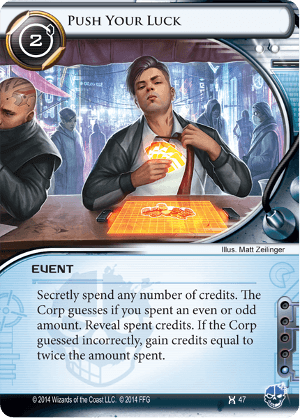
This advice might feel out of place and disconnected from the other points, but I feel it’s worth a slot in the article. Variance is a key part of every card game that I know of, and that includes Android: Netrunner. I believe that understanding what makes a game tick will make you a better player, On the grandest scale, no player is consistently lucky or unlucky, and chances are, if you just went to three 64 player regionals and came 35th at each one, it wasn’t bad luck that meant you didn’t make the cut; on the flip-side, if you just played three 64 player regionals and won each one, chances are it wasn’t luck that you won all three. On a smaller scale, this means that you shouldn’t be angry if your Accelerated Beta Test hits the only three agendas you had left in your otherwise ICE-filled deck, and understand that the fact that it happened this time doesn’t necessarily mean it was a bad decision.
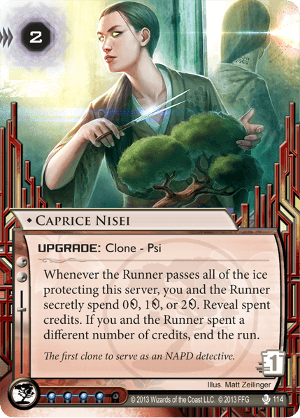 Everybody’s favourite Psychic Detective
Everybody’s favourite Psychic Detective
To expand upon that last point a bit more, you could make a play that gives you a 66% chance to win but a 33% chance to lose. If you lose from this play, it is important to remember that you didn’t (necessarily) make a bad decision, and it was not (necessarily) a bad play to make (unless there was a line of play with better odds to win/lose). Of course, variance is not biased, so you could make a play that gives you an 20% chance to win and a 80% chance to lose, and it could well make you win, but that does not (necessarily) make the play correct (it could have been correct if it was the line of play with the best odds to win/lose). The flip-side of variance is something people forget often, and statements like “I only win games I don’t get unlucky in” very usually ignore the times they got lucky and won because of that. Remember that the outcome — both positive and negative — of your plays isn’t necessarily indicative of how correct they were to make, and this is one of the many factors that makes Netrunner so hard to improve at for a lot of people. As counter-intuitive as it is, a play that made you lose could have been the best choice and would make you win the highest percent of the time.
Blaming variance for losses isn’t what the last two paragraphs covered, so I want to quickly mention it here. Winning or losing a game doesn’t always come down to play skill, but it doesn’t always come down to variance either. Even if your opponent won because they made a “lucky” run, was there anything you could have done to reduce the odds? Was there any way you could have denied them the chance? The answer to these questions is sometimes no, but I feel like complaining about that fact is a waste of time, and it doesn’t inherently make you a better player if the only games you lost were to “lucky” plays. Variance is a part of the game and it should factor into your decisions. Calculate the odds and make the best plays around those odds. You never “deserve” or “didn’t deserve” a win that comes down to something you deem lucky.
6: Analyse Your Opponent’s Played Cards, Archives, and Heap
The Archives/Heap is a veritable goldmine of information, so you should always be aware what’s in there. It would be foolish not to gain every advantage you can from information that is open for you to look at! Here are a few things that you can learn from looking at your opponent’s heap, both over the course of the game and as they discard cards. People don’t discard randomly, and a lot can be learnt by what they put in their bin:
- How much influence has been used so far, and therefore how much influence is left in their deck. Very important to know what tricks might be coming your way.
- How many copies of cards are left in their deck. Chances are, if Gabriel Santiago has played two copies of Account Siphon, there’s another one there somewhere.
- What their deck composition looks like, both overall and at the current point in the game.
- What cards are left in their deck or facedown on the board. As a brief example of this point, if you see two pieces of bulky ICE sitting in Archives and they’re an otherwise low-to-the-ground Near Earth Hub: Broadcast Center fast advance deck, chances are they don’t have much left.
- What they can get back if they play a card like Clone Chip or Interns.
- What cards that you’ve accessed (or seen with cards like Salem’s Hospitality) in the past have been discarded to hand size for whatever reason now? What does this mean?
- What cards are in their hand. This one’s another one I want to explain. If a Criminal player discards a Corroder from their hand, you just learned (at least) two pieces of information. Firstly, they (probably) have a Corroder in their hand (or, less likely, a way to get one). Secondly, to evidence an earlier point in this section, you just learnt that they (probably) have spent four influence on Corroder. This can also be of course stuff like your opponent discarding economy cards: what does that mean? Remember, people don’t discard randomly.
To be clear, you can (and in a perfect world, would) also get this information as the game is going on by simply adding up the cards they’ve played as the game goes, but I specifically say Archives/Heap because that’s where it ends up. Sometimes things like influence can be a little mentally taxing to track. Knowing what your opponent has played is the key part of this point, but don’t be afraid of double checking in the Archives/Heap to make sure.
7: Don’t Be Afraid of Giving Up Points
One of my good friends, James, was struggling to win with Jinteki: Replicating Perfection leading up to UK Nationals 2015. I have a wealth of experience with the ID and it’s one of my most played Corp IDs at tournaments, whereas he’d only picked it up recently. I sat next to him through a couple of games and talked with him through them to hopefully try and help. It very quickly became apparent to both of us that one of the problems was a fear of attempting to score an agenda if R&D was still easy to get in or if there was a small chance that the Runner could break through his lategame remote. This fear is something that’s easy to have and it’s something that James had to overcome, and I’m certain a lot of other players are struggling with this very thing. The reason not to be fearful is twofold: firstly, even if they can get into R&D, you should take any deal that gives you an agenda (and all of its benefits, like Nisei MK II) but only gives the runner the chance to get an agenda. Secondly, if they have a small chance of getting into your lategame remote, then it’ll usually completely bankrupt them if they do, meaning you’ve a clear path to start pushing out another agenda next turn.
Getting agendas from a scoring remote server will (usually, or more accurately, should) cost the Runner a lot of money or resources (e.g. Cerberus “Lady” H1 counters or cards for Faust). There are plenty of times where you’ll happily drain the runner’s credits for the cost of a few agenda points, usually when it means you can score some agendas because that swing makes your remote impenetrable for at least a few turns in the future. If it’s correct to let your opponent take an agenda (from any server) to retort with your own, then that’s a line of play that you should be happy to make. Though you shouldn’t exactly be handing out agendas for free, you don’t need to have every server on absolute lock-down, and it’s practically impossible to get to that point anyway. The chance that a runner can steal an agenda is a perfectly acceptable cost when scoring your own.
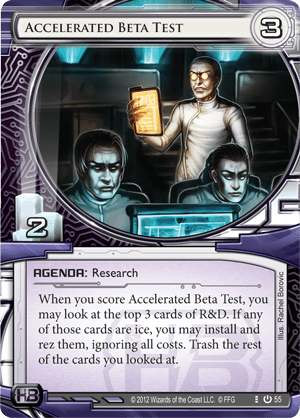 FIRE THE BETA TEST!
FIRE THE BETA TEST!
A good example of this rule in action is the time-honoured tradition of Haas Bioroid decks firing Accelerated Beta Test. There are plenty of cases where it’s okay to lose an agenda to get some more ICE, and indeed, the reason that there are some times where you want to fire Accelerated Beta Test without a card like Jackson Howard to save you if things go wrong is a perfect example of this rule in action. Maybe-losing-an-agenda isn’t always the end of the world and is sometimes very much the correct decision (how much it’s the correct decision is not something I’ll discuss here, though it’s absolutely not 100% or 0%), though I see some players who will never, under any circumstances fire ‘unsafe’ Accelerated Beta Tests, which is, I believe, most certainly a mistake.




